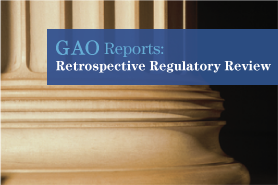Overview - Retrospective Regulatory Review
Related GAO Products
Financial Regulation: Clearer Goals and Reporting Requirements Could Enhance Efforts by CFTC and SEC to Harmonize Their Regulatory Approaches
Financial Regulation: Industry Trends Continue to Challenge the Federal Regulatory Structure
Economic Performance: Highlights of a Workshop on Economic Performance Measures
Environmental Protection: Assessing the Impacts of EPA's Regulations Through Retrospective Studies
 Recent public debate has focused on the impact of federal regulations on the economy and how agencies might improve existing regulations within their given statutory authorities and restrictions. Retrospective reviews of existing regulations provide a means by which agencies may (within the scope of their respective statutes) be able to reexamine the costs and benefits of regulations, assess the effectiveness of their implementation, and analyze how they have contributed to specific policy goals. For a number of years, agencies have conducted these reviews in response to congressional and presidential requirements or directives as well as at their own discretion under their general regulatory authorities. In reviewing agencies' retrospective regulatory review activities, GAO has reported on factors that facilitated or impeded retrospective reviews and identified opportunities to improve the effectiveness and transparency of such reviews.
Recent public debate has focused on the impact of federal regulations on the economy and how agencies might improve existing regulations within their given statutory authorities and restrictions. Retrospective reviews of existing regulations provide a means by which agencies may (within the scope of their respective statutes) be able to reexamine the costs and benefits of regulations, assess the effectiveness of their implementation, and analyze how they have contributed to specific policy goals. For a number of years, agencies have conducted these reviews in response to congressional and presidential requirements or directives as well as at their own discretion under their general regulatory authorities. In reviewing agencies' retrospective regulatory review activities, GAO has reported on factors that facilitated or impeded retrospective reviews and identified opportunities to improve the effectiveness and transparency of such reviews.
Recent actions by the Congress and the President have addressed retrospective reviews. In January 2011, President Obama issued Executive Order 13563, which supplements a previous executive order. The new executive order directs agencies to submit to the Office of Management and Budget's (OMB) Office of Information and Regulatory Affairs (OIRA) a preliminary plan, consistent with laws and agencies' resources and regulatory priorities, under which the agencies will periodically review their existing significant regulations (those that may have an annual effect on the economy of $100 million or more, among other things) to determine whether they should be modified, streamlined, expanded, or repealed. In February 2011, the House of Representatives passed House Resolution 72. Among other things, this resolution directs 10 congressional committees to inventory and review existing regulations and orders from federal agencies within their respective jurisdictions, particularly with respect to the potential adverse impact of the regulations on jobs and economic growth.
The tabs above summarize information from prior GAO reports that highlight challenges and practices that could facilitate such retrospective reviews and provide information on tools, such as benefit-cost analysis, that may be used in conducting these reviews. They also identify selected current statutory and other requirements and directives related to retrospective reviews.
For more information, please contact Barbara Bovbjerg at (202) 512-7215, bovbjergb@gao.gov or Kate Siggerud at (202) 512-2834, siggerudk@gao.gov.








